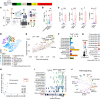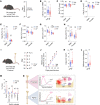Osteochondroprogenitor cells and neutrophils expressing p21 and senescence markers modulate fracture repair
- PMID: 38753433
- PMCID: PMC11178538
- DOI: 10.1172/JCI179834
Osteochondroprogenitor cells and neutrophils expressing p21 and senescence markers modulate fracture repair
Abstract
Cells expressing features of senescence, including upregulation of p21 and p16, appear transiently following tissue injury, yet the properties of these cells or how they contrast with age-induced senescent cells remains unclear. Here, we used skeletal injury as a model and identified the rapid appearance following fracture of p21+ cells expressing senescence markers, mainly as osteochondroprogenitors (OCHs) and neutrophils. Targeted genetic clearance of p21+ cells suppressed senescence-associated signatures within the fracture callus and accelerated fracture healing. By contrast, p21+ cell clearance did not alter bone loss due to aging; conversely, p16+ cell clearance, known to alleviate skeletal aging, did not affect fracture healing. Following fracture, p21+ neutrophils were enriched in signaling pathways known to induce paracrine stromal senescence, while p21+ OCHs were highly enriched in senescence-associated secretory phenotype factors known to impair bone formation. Further analysis revealed an injury-specific stem cell-like OCH subset that was p21+ and highly inflammatory, with a similar inflammatory mesenchymal population (fibro-adipogenic progenitors) evident following muscle injury. Thus, intercommunicating senescent-like neutrophils and mesenchymal progenitor cells were key regulators of tissue repair in bone and potentially across tissues. Moreover, our findings established contextual roles of p21+ versus p16+ senescent/senescent-like cells that may be leveraged for therapeutic opportunities.
Keywords: Aging; Bone biology; Bone disease; Cellular senescence.
Figures







Update of
-
Osteochondroprogenitor cells and neutrophils expressing p21 and senescence markers modulate fracture repair.bioRxiv [Preprint]. 2024 Feb 7:2024.02.01.578420. doi: 10.1101/2024.02.01.578420. bioRxiv. 2024. Update in: J Clin Invest. 2024 May 16;134(12):e179834. doi: 10.1172/JCI179834. PMID: 38370844 Free PMC article. Updated. Preprint.
Similar articles
-
Targeting senescent cells to boost bone fracture healing.J Clin Invest. 2024 Jun 17;134(12):e181974. doi: 10.1172/JCI181974. J Clin Invest. 2024. PMID: 40047888 Free PMC article.
-
Osteochondroprogenitor cells and neutrophils expressing p21 and senescence markers modulate fracture repair.bioRxiv [Preprint]. 2024 Feb 7:2024.02.01.578420. doi: 10.1101/2024.02.01.578420. bioRxiv. 2024. Update in: J Clin Invest. 2024 May 16;134(12):e179834. doi: 10.1172/JCI179834. PMID: 38370844 Free PMC article. Updated. Preprint.
-
Targeted clearance of p21- but not p16-positive senescent cells prevents radiation-induced osteoporosis and increased marrow adiposity.Aging Cell. 2022 May;21(5):e13602. doi: 10.1111/acel.13602. Epub 2022 Apr 1. Aging Cell. 2022. PMID: 35363946 Free PMC article.
-
Cellular Senescence in Diabetes Mellitus: Distinct Senotherapeutic Strategies for Adipose Tissue and Pancreatic β Cells.Front Endocrinol (Lausanne). 2022 Mar 31;13:869414. doi: 10.3389/fendo.2022.869414. eCollection 2022. Front Endocrinol (Lausanne). 2022. PMID: 35432205 Free PMC article. Review.
-
The role of p21 in cellular senescence and aging-related diseases.Mol Cells. 2024 Nov;47(11):100113. doi: 10.1016/j.mocell.2024.100113. Epub 2024 Sep 19. Mol Cells. 2024. PMID: 39304134 Free PMC article. Review.
Cited by
-
Effects of aging on the immune and periosteal response to fracture injury.Bone. 2025 Sep;198:117524. doi: 10.1016/j.bone.2025.117524. Epub 2025 May 15. Bone. 2025. PMID: 40381878
-
Mapping epidermal and dermal cellular senescence in human skin aging.Aging Cell. 2025 Jan;24(1):e14358. doi: 10.1111/acel.14358. Epub 2024 Oct 6. Aging Cell. 2025. PMID: 39370688 Free PMC article.
-
Targeting senescent cells to boost bone fracture healing.J Clin Invest. 2024 Jun 17;134(12):e181974. doi: 10.1172/JCI181974. J Clin Invest. 2024. PMID: 40047888 Free PMC article.
-
Cellular senescence in age-related musculoskeletal diseases.Front Med. 2025 Jun;19(3):409-426. doi: 10.1007/s11684-025-1125-7. Epub 2025 May 2. Front Med. 2025. PMID: 40314896 Review.
References
MeSH terms
Substances
Grants and funding
LinkOut - more resources
Full Text Sources
Molecular Biology Databases

